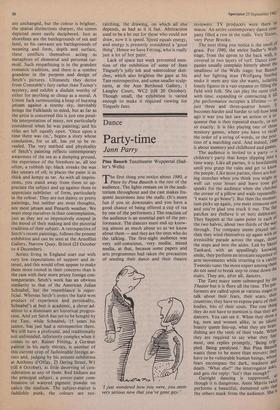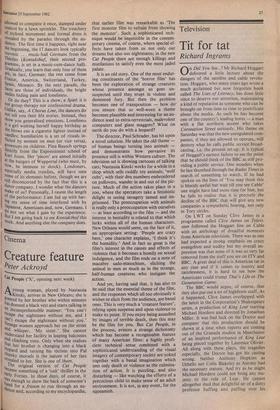Dance
Party-time
Jann Parry
Pina Bausch Tanztheater Wuppertal (Sad- ler's Wells)
The first thing you notice about 1980, a Piece by Pina Bausch is the rest of the audience. The lights remain on in the audi- torium throughout and the cast makes fre- quent incursions into the stalls. (It's more fun if you sit downstairs and you have a good chance of being offered a cup of tea by one of the performers.) The reaction of the audience is an essential part of the per- formance. The dancers must end up know- ing almost as much about us as 'we know about them — and they are the ones who do the talking. The first-night audience was very self-conscious, very media; mixed media, at that, because some papers and arts programmes had taken the precaution of sending their dance and their theatre
'I just wondered how you were, you seem very serious now that you've gone gay.'
reviewers. TV producers were there en masse. An entire contemporary dance com- pany filled a row in the stalls. Very Sixties, very Peter Brooke. The next thing you notice is the smell of grass. For 1980, the entire Sadler's Wells stage, from the apron to the back wall, is covered in two layers of turf. Dance com- panies usually complain bitterly about the smallness of the Wells stage; but Bausch and her lighting man (Wolfgang Seuthe) make it seem any size she wants, isolating lonely figures in a vast expanse or filling the field with folk. She can play the same trick with time. expanding or contracting it till the performance occupies a lifetime — or just three and three-quarter hours. It becomes harder and harder to tell how long ago it was you last saw an action or a se- quence that is then repeated exactly, or not so exactly. It is like playing one of those memory games, where you have to recall the order of a string of words, or the posi- tion of a matching card. And indeed, /980 is about memory and childhood and games.
The audience is invited to a party — a children's party that keeps slipping into a time warp. Like all parties, it is bewildering until you grasp the rules and get to know the people. Like most parties, there are bor- ing stretches when you think you might as well cut your losses and leave (one girl speaks for the audience when she clutches the corner of a pillow and wails repeatedlY, 'I want to go home'). But then the momen- tum picks up again, you meet someone new and you're glad you stuck it out. The flat patches are (believe it or not) deliberate. They happen at the same point in each of the two halves, about two thirds of the waY through. The company seems played out: then they wind themselves up again with an irresistible parade across the stage, clown the steps and into the aisles. Led by Meryl Tankard, with an appallingly knowing, smile, they perform an intricate sequence of arm movements while strutting to a catchY Twenties tune: the more expert among them do not need to break step to come down the stairs. They are, after all, dancers. The Tanz many seem submerged by the Theater but it is there all the time. The per' formers are called upon at various stages to talk about their fears, their scars, their countries; they have to expose parts of their bodies, bits of their souls. The one thing they do not have to mention is that they are dancers. You can see it. When they show 3 leg, men and women alike, in an idiotic beauty queen line-up, what they are bran' dishing are the tools of their trade. When they are required to say what they fear most, one replies promptly, 'Being crir pled. Being paralysed.' But Pina Bausch wants them to be more than movers; they have to be vulnerable human beings, whose fears encompass the dark, madness and death. 'What else?' the interrogator asks' and gets the reply: 'Isn't that enough?' 5 Outright dancing is suppressed, a though it is dangerous. Anne Martin twice performs a beautiful, demented solo that the others mask from the audience. She 15 allowed to complete it once, damped under control by a lawn sprinkler. The treachery of stylised movement and formal dress is revealed by the parades through the au- dience. The first time it happens, right near the beginning, the 17 dancers look typically teutonic ... music-hall Germans from the Thirties (Kontakthof, their second pro- gramme, is set in a music-cum-dance hall). Gradually, you learn that only four of them are, in fact, German; the rest come from France, America, Switzerland, Turkey, ,Spain, Monaco. By the next parade, the faces are those of individuals, the bright smiles hiding pain and loneliness.
Or do they? This is a show, a Spiel: it is not group therapy nor confessional drama. Unlike, say, A Chorus Line, the dancers do not tell you their life stories. Instead, they show you generalised emotions. Loneliness Is a girl wishing herself happy birthday as she blows out a cigarette lighter instead of candles; humiliation is a set of rituals in- flicted by women on men (or vice versa), grownups on children. Pina Bausch springs directly from the Expressionist school of Kurt Jooss. Her `pieces' are aimed initially at the burgers of Wuppertal (who must, by 40`,v, be immune to shock). Londoners, especially media trendies, will have seen some of its elements before, though we are still disconcerted by the fact that this is a dance company. I wonder what the dancers make of us? Personally, I resent the length Of the performance: I am fed up with hav- ing my sense of time interfered with by Japanese, Americans and, now, Germans. I do not see what I gain by the experience. But I am going back to see Kontakthof this Week. And anything else the company does.



































 Previous page
Previous page